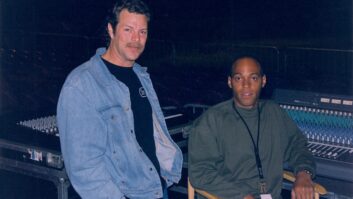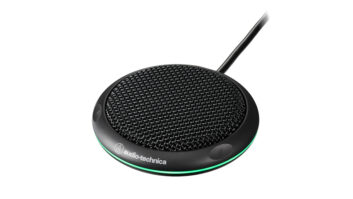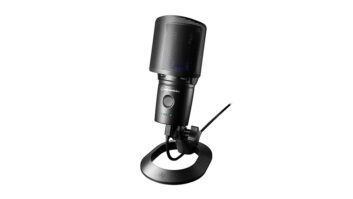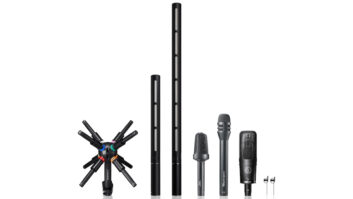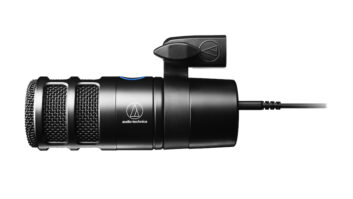
Anticipated since 1994, when Audio-Technica first unveiled its
AT4050 large-diaphragm studio condenser, A-T’s tube mic project
may have been one of the worst-kept secrets in audio. Everybody knew
this one was coming, but after beta testing on major-label sessions for
a year or so (these guys at A-T are really careful), the AT4060 tube
mic ($1,695) is finally here. Deliveries begin later this month, and
this is one serious mic to reckon with.
The mic is a side-address design, shaped similar to the AT4050,
although the AT4060 has a larger body and weighs in at a substantial
640 grams. The brass body has a tough matte-black finish. The cardioidcondenser capsule uses an aged, 21.3mm-diameter
vapor-deposited gold diaphragm. In keeping with its minimalist design,
the AT4060 has no pad or HP filter in the audio path, and its extremely
stable 6922 tube provides remarkably low noise for a tube mic. Combined
with its maximum SPL handling of 149 dB (0.5% THD), the AT4060 offers enough dynamic range for nearly any session, whether
hyper-analog or 20/24-bit.
A 10-meter cable with 6-pin Neutrik XLRs connects the mic to a 1U power supply with
detachable rack ears. Of little use in a control room (unless your
facility is prewired for 6-conductor mic lines), a rackable PS would
ideally be mounted in a case, for transport/setup when several AT4060s
are used on a session. The PS front panel has an AC switch and power
LED; the rear has switches for ground lift and 120/230 VAC operation,
along with the 6-pin XLR input and 3-pin male XLR output. The mic
includes an industrial-strength shockmount: a cast aluminum frame with
thick elastic cording suspending an inner cradle that holds the mic
securely, yet provides superb isolation from kicks, slams, stomps and
seismic phenomena.
Tube gear requires a warm-up period, so I powered up the AT4060 and
listened to about five minutes of occasional pops, burps and some
cool-sounding frequency sweeps that sounded like outcasts from the
soundtrack of Ed Wood’s 1959 classic Plan 9 From Outer Space.
After ten minutes, the AT4060 stabilized and was ready to go.
Using a Millennia Media HV-3 preamp, my first session with the
AT4060 was recording male narration for an industrial training cassette
series (hey, don’t laugh—these gigs pay really well). I
noticed that the AT4060’s frequency response seems to go all the
way down to subsonics—what would have been an attenuated breath
pop on a lesser mic sounded like a hurricane on the AT4060. This thing
would be great on pipe organ! My trusty Popper Stopper® screen
about 2 to 3 inches in front of the mic took care of the breath noise,
while placing the narrator 8 to 10 inches back from the AT4060 offered
unhyped, natural reproduction.
On both male and female vocals, the AT4060’s proximity effect was just enough to add a nice
bass edge to a singer who knows how to work a mic, yet it was never
overbearing. More impressive perhaps was that the proximity effect was
linear across the LF band, free of peaky frequency hot spots that can
make certain notes jump out and muddy up a performance. Spec’d
with a 20kHz bandwidth, the mic has a -3dB downpoint around 18
kHz—more than ample to capture the shimmering airiness on breathy
vocals.
In the upper middle range of the scale, the AT4060 exhibits a very
gently rising presence boost starting about 2 kHz, gradually edging up
to a 2- to 3dB crest around 6 kHz and remaining linear to past 10 kHz.
This worked out extremely well on male and female voices for a pinch of
clarity and definition, without the brittleness that can result from a
mic with overexaggerated top end. This presence provided a nice
openness on grand piano, 12-string guitar and sax—instruments
that can become shrill with the wrong mic.
Although it takes SPLs of 149 dB, I resisted the urge to use the
AT4060 inside a rock kick, where air turbulence can permanently deform
a delicate mic diaphragm. However, the AT4060 was nice and round on a
double-headed jazz kick and excelled as a close mic on guitar and bass
cabinets, offering power and punch while faithfully capturing the
amps’ sound.
The bottom line? If you need a quality studio mic with an
unexaggerated, natural sound that’s suitable to both male and
female voices, as well as being an excellent all-around performer in a
variety of studio tasks, the AT4060 could be just the ticket. Thumbs up
on this one!
Audio-Technica U.S., www.audio-technica.com
